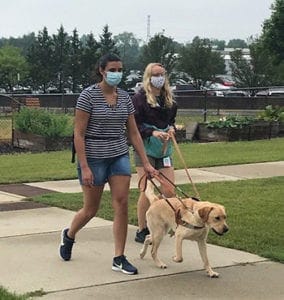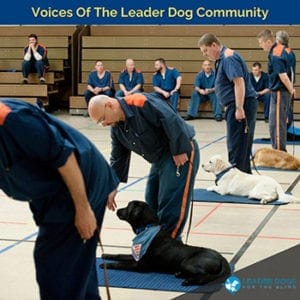
A year ago, the Leader Dog campus had radically transformed in just one week. Our classes—canceled. Tours and events were the same. Our team members and volunteers mostly disappeared from campus, faced with the sudden reality that we didn’t know how—or even if—we could still do our jobs. As it was for the rest of America and the world, everything we knew and took for granted seemed to be grinding to a halt.
However, Leader Dog had a plan. Team members who could feasibly work at home were instructed to do so until at least early April. A crew remained working on campus to care for our dogs and puppies. Many other of the dogs in our canine development center went home with team members who volunteered to care for them and maintain their training. Many of us weren’t really aware of just how much change this would all bring. The things that seemed like big adjustments at first—holding meetings over video conferencing, finding space at home to set up a desk, working with our children in the next room—snowballed into bigger transformations as time went on.
 After we received permission to begin providing services again, our training team adapted to nimbly change our Guide Dog Training service model to what was best for our clients and team from week to week, even day to day. There have been times it was deemed safe to have clients on campus with smaller class numbers, limited interaction and a multitude of safety protocols in place. At other times, the training team has shifted to the home delivery model, which limits each instructor’s interaction during a class to just one client. Our clients and prospective clients waited patiently for their time to begin instruction, and it hasn’t always been clear just when that would be able to take place.
After we received permission to begin providing services again, our training team adapted to nimbly change our Guide Dog Training service model to what was best for our clients and team from week to week, even day to day. There have been times it was deemed safe to have clients on campus with smaller class numbers, limited interaction and a multitude of safety protocols in place. At other times, the training team has shifted to the home delivery model, which limits each instructor’s interaction during a class to just one client. Our clients and prospective clients waited patiently for their time to begin instruction, and it hasn’t always been clear just when that would be able to take place.
For our events, everything was up in air at first. Would it be safe to hold gatherings by June, when we host Bark & Brew? Surely by March, where hundreds of people gather to attend Dinner in the Dark? Eventually, it became clear that we could not rely on any of the events as we’ve held them in the past to take place. Event participants help us raise thousands of dollars every year, and now a huge question mark hung in the air in place of that expected revenue. But just as it was everywhere else on campus, the brainstorming began in earnest. Hosting events is about more than just raising funds; it’s a way to connect with the people who support our mission. How could we connect with people when were so limited in our interactions?
 During this year of evolution, our team created many brand-new initiatives to tackle the challenges caused by a global pandemic. We created Alumni Hour, a regular event where our clients can virtually join in to learn about Leader Dog news and to just chat with each other. We launched T.O.M. Talks, which invited adults between the ages of 18 and 24 who are blind to virtually learn about independent travel, professional readiness and networking. We held the first Great Leader Dog Picnic, which allowed people to participate in an event that could maintain social distancing. Dinner in the Dark underwent a transformation that let people from anywhere join in with mailed kits and a virtual program. We created a Virtual Learning platform for people from many different subsets of our community to find out more about subjects like cane travel, coming home with a Leader Dog, accessible pedestrian signs and more. Our puppy development team began virtual events for raisers who could not meet up and train together as they used to, and they created online modules to help guide raisers through the basics of their time with a Future Leader Dog. Summer Experience Camp has traditionally been a time for teens to gather on our campus for a week of learning and fellowship, but in 2020 the entire program was reworked to be accessible in an online format.
During this year of evolution, our team created many brand-new initiatives to tackle the challenges caused by a global pandemic. We created Alumni Hour, a regular event where our clients can virtually join in to learn about Leader Dog news and to just chat with each other. We launched T.O.M. Talks, which invited adults between the ages of 18 and 24 who are blind to virtually learn about independent travel, professional readiness and networking. We held the first Great Leader Dog Picnic, which allowed people to participate in an event that could maintain social distancing. Dinner in the Dark underwent a transformation that let people from anywhere join in with mailed kits and a virtual program. We created a Virtual Learning platform for people from many different subsets of our community to find out more about subjects like cane travel, coming home with a Leader Dog, accessible pedestrian signs and more. Our puppy development team began virtual events for raisers who could not meet up and train together as they used to, and they created online modules to help guide raisers through the basics of their time with a Future Leader Dog. Summer Experience Camp has traditionally been a time for teens to gather on our campus for a week of learning and fellowship, but in 2020 the entire program was reworked to be accessible in an online format.
 Every organization wants to be capable of changing with the times, but this past year has been so much more than evaluating a technology upgrade or adding new activities to our classes. It’s easier to think of things that have changed rather than those that remain the same. But with the dedication of everyone who is a part of the Leader Dog community, uncertainty has become flexibility. In a year where many services were unavailable, we were able to find ways to safely support those people who need our programs the most, connect with the people in our community, and continue to support our team members and volunteers. At this time, clients are still meeting and training with their Leader Dogs, preparing for a successful partnership for years to come. It’s an achievement that we take immense pride in.
Every organization wants to be capable of changing with the times, but this past year has been so much more than evaluating a technology upgrade or adding new activities to our classes. It’s easier to think of things that have changed rather than those that remain the same. But with the dedication of everyone who is a part of the Leader Dog community, uncertainty has become flexibility. In a year where many services were unavailable, we were able to find ways to safely support those people who need our programs the most, connect with the people in our community, and continue to support our team members and volunteers. At this time, clients are still meeting and training with their Leader Dogs, preparing for a successful partnership for years to come. It’s an achievement that we take immense pride in.
So far in 2021, our campus is still quieter than it was before COVID-19 changed everyone’s lives. Many of us still don’t regularly work on campus, and those who do are in separate spaces. There are fewer opportunities to stroll down to someone’s office and check in with each other, whether for a project or just to say hi. We still feel the loss of connection with each other, with our dedicated volunteers and supporters. We’ve felt the uncertainty of trying new things and having no way to know for certain that we’d succeed. But the Leader Dog community is strong. We believed in each other and in our mission, and the volunteers, Lions clubs and donors and supporters believed in that too. Our clients trusted us to do everything we could to keep our programs going—and to keep them safe. As we move forward, still not knowing what the impact of the pandemic will ultimately be, we are confident that our mission is strong enough to last through anything yet to come.
Last March, we posted about the changes on campus a week after Michigan started to implement stay-at-home orders. You can see that post here.

 My first encounter with a puppy on the inside occurred after having already served 16 years. I was on a transfer layover in the Upper Peninsula when a guy walked by with a puppy. It blew my mind. Unless you have experienced going so long in a dehumanizing environment, words are probably not going to convey the “vibe” that a person feels when in the presence of a puppy; it is a strong, palpable feeling that is almost spiritual. People become aware of this sense when a stimulus, like a puppy, is reintroduced into the environment after having been removed for a long time. Puppies have a positive effect upon every prison that they are in.
My first encounter with a puppy on the inside occurred after having already served 16 years. I was on a transfer layover in the Upper Peninsula when a guy walked by with a puppy. It blew my mind. Unless you have experienced going so long in a dehumanizing environment, words are probably not going to convey the “vibe” that a person feels when in the presence of a puppy; it is a strong, palpable feeling that is almost spiritual. People become aware of this sense when a stimulus, like a puppy, is reintroduced into the environment after having been removed for a long time. Puppies have a positive effect upon every prison that they are in. A lot of raisers use every meal to train their puppies. The time and drive it takes to obedience train a puppy like this develops consistent discipline that carries over into other areas of life. This happens because of Prison Puppies. No other prison rehabilitation program does this!
A lot of raisers use every meal to train their puppies. The time and drive it takes to obedience train a puppy like this develops consistent discipline that carries over into other areas of life. This happens because of Prison Puppies. No other prison rehabilitation program does this! The challenge of living with so many different people in a crowded environment while trying to raise well-mannered, obedient puppies caused me to discover the subject of social intelligence. Without being a part of Prison Puppies, social intelligence wouldn’t have been a practical necessity for living because many successful prisoners limit the people they interact with on the inside. They have changed so much that their social circle shrinks. Or, successful prisoners limit their interactions simply because it’s easier to stick to themselves. A common compliment in prison is “That guy sticks to himself.” Books, movies, games or working out are ways successful prisoners check out of the prison social life.
The challenge of living with so many different people in a crowded environment while trying to raise well-mannered, obedient puppies caused me to discover the subject of social intelligence. Without being a part of Prison Puppies, social intelligence wouldn’t have been a practical necessity for living because many successful prisoners limit the people they interact with on the inside. They have changed so much that their social circle shrinks. Or, successful prisoners limit their interactions simply because it’s easier to stick to themselves. A common compliment in prison is “That guy sticks to himself.” Books, movies, games or working out are ways successful prisoners check out of the prison social life.
 Each team usually consists of two people and a puppy. One person signs the contract, just like they do in society, and the other member is listed as a secondary handler. Some facilities have three-person teams where inmates are housed in “cubes.” Cubes are like office cubicles, but these are in pole barns. I started puppy raising in a cube but finished in a cell with one other person and our assigned puppy.
Each team usually consists of two people and a puppy. One person signs the contract, just like they do in society, and the other member is listed as a secondary handler. Some facilities have three-person teams where inmates are housed in “cubes.” Cubes are like office cubicles, but these are in pole barns. I started puppy raising in a cube but finished in a cell with one other person and our assigned puppy. Over time we work to regain the trust of those close to us and meet new people. Eventually we discover that our experiences, though painful, forged exceptional qualities that have a powerful ability to assist humanity in ways that only the marginalized can. There are many good people in prison who have discovered for themselves that they have become exceptional. For downcast people, the challenge is overcoming a negative self-image. However, once prisoners realize they have something valuable to offer because of their experiences, they have a social impact that the average person doesn’t seem to have. Most prison puppy raisers are people who have become, or are becoming, exceptional in comparison to the average person in society. They become inspiring people, they’re my people, and I love them!
Over time we work to regain the trust of those close to us and meet new people. Eventually we discover that our experiences, though painful, forged exceptional qualities that have a powerful ability to assist humanity in ways that only the marginalized can. There are many good people in prison who have discovered for themselves that they have become exceptional. For downcast people, the challenge is overcoming a negative self-image. However, once prisoners realize they have something valuable to offer because of their experiences, they have a social impact that the average person doesn’t seem to have. Most prison puppy raisers are people who have become, or are becoming, exceptional in comparison to the average person in society. They become inspiring people, they’re my people, and I love them!